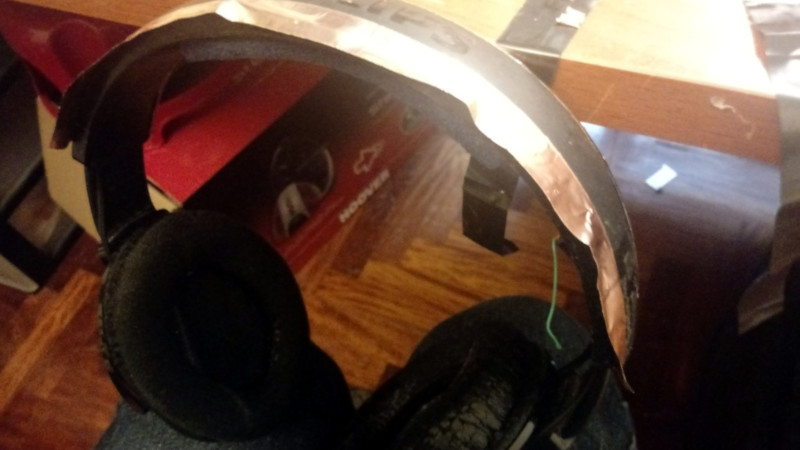We’re all used to the idea of wireless charging, usually in the form of an induction coil on which a mobile phone or other appliance can be placed for a top-up. Not every battery-powered appliance has a built-in wireless charging coil though, meaning that despite the tech being available we all still have a jumble of wires.
[Sergio Costas] has a simple solution to conjuring wireless charging from thin air in his headphone stand, which conceals a set of charging contacts. It’s by no means a new idea and it might seem like an obvious hack, but it undeniably does away with the wires and we like it. After all, if it were that obvious, none of us would have that mess of chargers.
The headphones in question are a Bluetooth wireless pair, and the charging contacts have been brought out via a voltage regulator and a bridge rectifier to a pair of copper tapes along the sides of the headband. These mate with matching contacts in a 3D printed holder to which 12 VDC has been applied. Perhaps he’s just reinvented the springy contacts you’ll find on any cordless home phone, but it’s unquestionably a charger without wires.
Meanwhile if you have a conventional wireless charger, how do you know it’s working?















If crystal radios can deliver audio without batteries/external power from a radio source 100 miles away, why can’t we build a wireless headset using the same concept that can receive RF from your phone or computer from ~6ft away?
Because the crystal ear piece is very high impedance, very low volume, and awful quality. They probably consume a millionth of what active headphones with a bidirectional wireless link and audio processing use to achieve the quality and volume that people demand.
Because for that you must use AM, and you couldn’t avoid interference, noise… the volume would be very low… Thus, very, very low quality sound. Also, you couldn’t share the bandwidth, which means that you would run out of it as soon as you have one or two neighbours…
This can also be done with FM, VHF crystal radios with slope detection have been demonstrated decades ago. Also PWM and PAM will work. SSB and digital modulations are out, for obvious reasons.
But there is still the problem of the bandwidth and interference, and power. As I’m seeing, for FM crystal radios you need more transmission power than for AM, so you would produce even more interference for others (and to take fully advantage of the bigger selectivity of FM you can’t use a crystal radio). Also, FM requires more bandwidth than AM, and if you would have troubles assigning a band for each user in the vicinity using AM, with FM will be even worse. You need Spread Spectrum modulations if you want to allow everybody to use it without interfering with everyone else, and those can’t work without batteries. Also, you want a reasonable volume level, something that no crystal radio can provide.
FM doesn’t require more bandwidth. The fact that you want to reproduce sounds from 20HZ to 15KHZ requires more bandwidth. AM bandwidth was assigned that way because it was primarily used for speech which can be understood by cutting off at around 3KHZ or even less. The commercial FM stations were meant to transmit hi fidelity music. In other words…. The amount of bandwidth required is determined by the fidelity and frequency range you need to modulate.
Frequency modulation DOES require more bandwidth. You must take into account the Carson bandwidth rule: https://en.wikipedia.org/wiki/Carson_bandwidth_rule
FM’s benefits mostly come from limiters, which eliminates static and any AM interference.
But a crystal radio lacks a limiter.
Imagine a world with such passively powered headphones … how would you prevent crosstalk from many devices in an urban environment and what kind of bandwidth do you think would be feasible? Would it be cheaper/more efficient from the perspective of the phone than bluetooth? Keeping in mind crystal radios have one transmitter and many receivers (not many transmitters and many receivers that all must be selective) and audio fidelity is not the main goal for its purposes. I have a feeling that it would be technically possible, but there would be too many compromises that would prevent it from being practical in the real world.
By the time a radio signal arrives at your radio, it’s pretty weak. Yet for a broad ast transmitter the signal is really strong at its antenna.
If you start with a weak signal, the receiver either needs close coupling to the transmitter, or amplification in the receiver. Most receivers have amplification even with strong transmitters.
You also have very little selectivity with crystal radios. Improving that means more loss, or more amplification.
Smart to use a backwards proof means of making the connection.
On an 18650 lithium charger I have it says, “forbids to invert”. Who? What?
I presume that your desire to live is what forbids you to invert it :-D
So, its just as my Sennheiser RS175, but diy… Cool! I like it. I paid premium for the AA battery and the charger as it is because its so much better than relying on usb connectors that will eventually stop working.
Daewoo already have a qi wireless charging headphones. And theyre charged using a qi wireless charging pad you use for phones too. They seem to be the only brand who have used this concept. To clarify, these are stereo heaphones NOT earbuds. And theyre awesome. Mine last for days on a single charge.
I don’t understand why pogo pins aren’t used on mobile phones and other devices. They are cheap and simple to use and proved to work well on wireless landline phones.
My guess, at the high charging speeds people expect pogos would present too high of a contact impedance. For relatively low speed data and power it’s not an issue though.